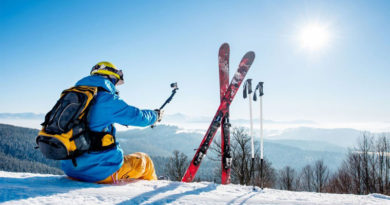Ski vs. Snowboard Helmet: A Comparison
Wearing a properly fitted helmet is the single most important thing you can do on the slopes to help prevent a serious injury. But do you wear a ski helmet or a snowboard helmet? Which one is better? Are they the same? These are certainly the type of questions many skiers or snowboarders ask at some point. Several brands sell ski and snowboarding-specific helmets. But they all look the same.
Those who know a bit about the history of skiing and snowboarding gear know the real marketing ploy at play here. It is really silly to label one helmet ski and the other snowboarding. You are out in the snow sliding down a mountain. How different does this stuff have to be
A little history lesson
Today, the terms “ski helmets” and “snowboard helmets” are used interchangeably or simply the term “snow helmets” for both sports. But that wasn’t always the case. Back in the 90s, snowboarders were considered “counter-culture”. Most brands weren’t interested in their needs.
As with any vacuum in the business world, it gave rise to new companies many of which we see as successful companies today. These emerging companies redesigned the whole skiing kit to cater to the needs of snowboarders.
Most ski helmets were full-type helmets that also covered the ears. These helmets were quite heavy. The heavyweight of the helmets used to change the center of gravity causing an issue during freestyle competitions. They were also uncomfortable and had no style.
Snowboard-specific brands paved the way for use of lighter materials and better styling. Burton’s subdivision, R.E.D., was the first one to introduce a super-light helmet, the still popular Hi-Fi. The helmet was an instant hit and sold like hotcakes. Snowboard-specific helmet manufacturers are also the pioneers of audio inclusion in snow helmets.
The sales numbers prompted the other manufacturers to reconsider their own products. The ski helmets were then redesigned to be the same as snowboard helmets. Today, the helmets for both sports are the same.
Why the separate labels then?
Marketing! It all comes down to marketing. Many manufacturers offer the same helmet for both, skiing and snowboarding. But the brands that do a lot of labeling seem to do it to keep the market share in that sport.
For snowboarders, the changes and modifications catering to their needs were welcomed. Brand loyalty was established through reputation as a result. If you take a look at snowboarding magazines, you would find many brands that skiers haven’t heard of. But some brands have crossed over, like R.E.D.
So, single helmet for both sports?
Yes! Skiers and snowboarders wear the same helmets. When manufacturers call it a “snowboard helmet”, they put graphics on it and prey upon the ignorance of the people. When an object slides against a surface, it is called skiing. Snowboarding is a form of skiing which is why you go to a “ski resort”.
The helmets are exactly the same because the same physics are involved. Snow helmets are built for impact, head protection, and thermal protection. There is nothing new in snowboarding and skiing that would change that. It’s only marketing.
How to fit your helmet?
If the helmet is too large or too small, it will not provide you with the adequate protection you need. So, here are a few tips to ensure a proper fit.
The first thing, you need to do is measure the size of your head. Use a soft tape to measure the circumference of your head just above the brow line. If you do not have a soft tape measure, a piece of string will do the work. Once you’ve measured your head and consulted the size chart, it’s time to try the helmet on.
Slide the helmet on the forehead first and then flip it over the back of your head. The helmet should fit snugly across your head and when you move the helmet, the skin on the forehead and eyebrows should move with it. If your helmet has a dial or an adjustable fit, give it a quick little turn. If a helmet is too large, it’ll flip and flop around on your head or if a helmet is too small, it will not sit down across the top of your head.
Chinstrap is designed to keep the helmet on your head in the event of a violent crash. It is not designed to keep the helmet on your head while riding.
It is purely up to the discretion of the rider if you want to wear a hat underneath your helmet. Somehow helmets allow for this, some do not. Keep in mind that a hat will compromise the fit and the amount of protection that is offered.
All ski and snowboard helmets are single impact protection helmets. This means that they are designed to withstand the impact of one single major impact to wear. If that helmet if you’ve taken a fall and that helmet is damaged or cracked either on the exterior shell or interior liner, it is time for a new helmet because that helmet will not safely protect you.




